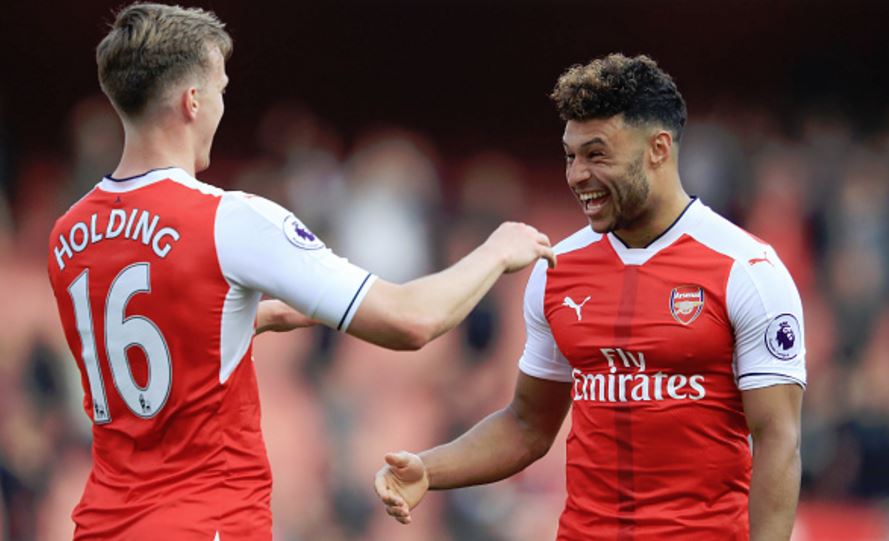This season, a new formation and tactical system swept the Premier League, and to some extent world football.
Previously, using three centre backs was something mostly seen in Italy. The 4-2-3-1 and 4-4-2 dominated English football.
But by the end of the 2016-2017 season, most teams had at least tried some form of three at the back. What changed? Why so quickly? Why did this system work so well for Arsenal?
Antonio Conte and the Copy Cats
At the beginning of the season, Chelsea were a joke.
They had just finished a terrible season, and Alexis Sanchez and Mesut Özil ripped them apart. Conte was expected to be fired at any second.
But then, he pulled out the formation he used frequently with Juventus and Italy: the 3-5-2 and 3-4-3. The Blues pulled a fullback, Cesar Azpilicueta, inside to one of the central spots. He had a fantastic season, surely one of their best players. This accommodated Marcos Alonso, allowing him to get forward, elbow Hector Bellerín in the head, and get goals.
The effects were immediate.
Chelsea completely turned their season around (unfortunately), eventually going on to win the title and almost the double (thank you Aaron!).
Antonio Conte having success with this system in England made it spread like wild-fire.
The Premier League went into complete copy-cat mode. First, struggling teams fighting to get any momentum gave it a try.
Hull City deployed it when they were out of answers, Tottenham used it in several games.
Even Gareth Southgate gave it a try with England against Germany.
All of these formation experiments were trying to replicate Chelsea’s immediate success upon switching formations.
These were a bit of a mixed bag. Sometimes it worked, sometimes not. This is probably due to the fact that Conte has much more experience deploying these formations than the other managers.
At Arsenal’s darkest hour, with Arsene Wenger desperate for results, the Gunners came out in a 3-4-3 against Middlesbrough.
Using the new system, Arsenal won 9 of their last 10 games in all competitions to bag an unlikely trophy and almost snatch fourth place.
Next, why it worked…
Why it worked
The new formation and system is perfectly suited the current crop of players.
Rob Holding and Shkodran Mustafi love to get forward. In a partnership, this left the defence completely exposed and vulnerable to the counter. In a trio, when one gets forward, there are still two central defenders to snuff out counter attacks.
The new system also let the wingbacks attack without fear of being exposed.
Moving Alex Oxlade-Chamberlain to this spot was one of the revelations of the season. Despite saying he wants to be a central midfielder, the Ox seems to have found a new home that will get him consistent playing time.
Surprisingly, Nacho Monreal also shone in his new role. Nacho had seemed on the out, with rumours circling for several transfer windows that Arsenal were in the market for a left back. But whether he played as the left centre back or as the left wingback, Nacho played exceptionally well. He even bagged the winner against Manchester City in the FA Cup semifinal.
All of the wingbacks shone going forward. Goals and assists abounded.
Monreal and Bellerín bagged goals. The Ox looked incredible swinging in crosses. In the Manchester United match, he logged two assists, including a beautiful cross right onto Danny Welbeck’s head.
https://twitter.com/MysticMO11/status/861267742405611520
Alexis Sanchez and Mesut Özil have always been players who like to roam. They do not like to stick to one positional area on the field.
Previously, this left Arsenal wide open after turning the ball over, which Sanchez does quite often. The 3-4-3 allows them this freedom.
They can go wherever they need to in order to create, without being exposed.
The solid defensive base and two strong central midfielders allow them to go anywhere on the pitch.
This led to a free-flowing attack that decimated opponents in the run in.
Next, for the future…
For the Future
Two questions remain: will Arsenal use this going forward, or was this a one-time deal; and will this system be as effective next year as it was this season?
Arsene Wenger is notoriously stubborn.
Will he go back to his old ways, or stick with the new system?
The results are hard to argue with. New signing Sead Kolasinac seems to be a player perfectly suited to the 3-4-3. Similarly to Monreal, he has played as the left wingback and the left sided centre back.
The system allows Arsenal to get their best players on the field with the fewest selection headaches.
When healthy, Holding, Koscielny, and Mustafi are three terrific central defenders. Having them all on the field at once gives Arsenal tremendous support at the back. It also lets Sanchez and Özil roam as they want to do.
Hopefully, Arsenal can replicate this run of form at the start of next season.
What remains to be seen is if the new system will be effective after a summer when managers have time to plan for it. All of the switches to a back three came mid-season, leaving opposing managers less time to figure out how to beat it.
After a full off-season of creating tactics to defeat it, will it still be as effective?
If Arsenal do decide to stick with the new system, hopefully it will be as effective as it was in the last ten games.
More silverware will surely be on the way if it is.
